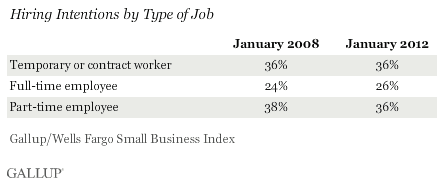PRINCETON, NJ -- By 22% to 8%, more U.S. small-business owners expect to increase than decrease the total number of jobs at their company over the next 12 months, according to a new Wells Fargo/Gallup Small Business Index poll conducted Jan. 9-13, 2012. This 14-percentage-point advantage for expected job growth is the largest since the +15 of January 2008, suggesting small-business owners are more optimistic about hiring now than at any time in the past four years.

Wells Fargo and Gallup survey 600 small-business owners quarterly to assess conditions within their companies as well as their outlook. The current hiring-intentions advantage is a sharp increase from +2 points in October 2011 and +4 points in July 2011, and is essentially the same as the +12-point advantage seen last January. Looking further back, the difference in small-business-owner hiring intentions reached a high of +25 in March 2004 (with 28% of small-business owners saying they intended to increase their employee base and 3% saying they intended to decrease it), and a low of -4 near the end of 2008 (14% increase vs. 18% decrease).
Self-Reported Hiring Remains Negative
Small-business owners are significantly more negative when asked to reflect on how much hiring they actually did in the past year. Fewer small-business owners reported increasing the number of jobs at their company (13%) than reported decreasing them (22%). This difference of -9 points is the same as what Gallup and Wells Fargo found in October 2011 and is similar to a year ago (-12). Small-business owners' self-reported hiring was the most negative at -27 in January 2010 and the most positive at +13 in December 2004.

It is worth noting that since the 2008 global economic collapse, the net percentage of small-business owners' self-reported actual job growth versus job cuts has generally remained negative, even when small-business owners say they are more likely to grow than contract.
Strong Preference for Temporary, Contract, or Part-Time Hires
When asked what type of workers they would hire if they were able to hire and had hiring needs, 26% of small-business owners said they would hire full-time employees, while 72% said they would prefer to add temporary or contract workers (36%) or part-time workers (36%). These are the same hiring preferences owners had in January 2008, when the recession was just getting underway.

Hard to Find Qualified Employees
Just over half of small-business owners report it is very (21%) or somewhat difficult (32%) to find the qualified employees they need for their businesses. This is down from 65% when Gallup and Wells Fargo last asked about this in 2005 and business conditions were much better. Finding qualified employees could be an even larger problem in the months ahead if small-business owners increase their hiring efforts significantly.

Twenty-one percent of owners say their inability to find qualified workers is hurting their business in January 2012, down from 27% in March 2005.
Implications
The increase in small-business owner hiring intentions over the past year is consistent with the strong performance of Gallup's Job Creation Index in January and the decline in the unemployment rate as measured by Gallup at mid-month.
At the same time, small-business owners have often expected to increase hiring in recent years but later reported that they actually eliminated more jobs than they created. So it remains to be seen whether the greater expectations for hiring in the next 12 months will become reality.
The preference of small-business owners for hiring temporary, contract, and part-time workers may help explain why Gallup is seeing increasing numbers of people working part time but wanting full-time work even when the unemployment rate is lower. Further, this preference may reflect the continued caution on the part of many small-business owners toward the U.S. economy. Just a year ago, many owners also hoped to significantly increase their hiring in 2011, but their current reports of hiring they did last year indicates that this did not happen.
Many small-business owners also continue to say they are having trouble finding qualified employees. This situation could end up hurting a lot more than one in five small businesses if hiring begins in earnest later this year. While small-business owners tend to be agile -- and have demonstrated their ability to adjust to the business cycle as needed to survive -- weak economic conditions have persisted since 2008.
Taken together, it is clear that America's small businesses and the U.S. economy are at a crucial juncture. Owners' increased optimism about hiring provides the potential for significant job growth in the months ahead if those intentions become reality.
About the Wells Fargo/Gallup Small Business Index
Since August 2003, the Wells Fargo/Gallup Small Business Index has surveyed small-business owners on current and future perceptions of their business financial situation. Visit the Wells Fargo Business Small Business Resource Center to access the full survey report and listen to Wells Fargo Senior Economist, Dr. Scott Anderson, in his quarterly Small Business Index podcast.
Survey Methods
Results for the total dataset are based on telephone interviews with 600 small-business owners, conducted Jan. 9-13, 2012. For results based on the total sample of small-business owners, one can say with 95% confidence that the maximum margin of sampling error is ±4 percentage points.
Sampling is done on an RDD basis using Dun & Bradstreet sampling of small businesses having $20 million or less of sales or revenues. The data are weighted to be representative of U.S. small businesses within this size range nationwide.
In addition to sampling error, question wording and practical difficulties in conducting surveys can introduce error or bias into the findings of public opinion polls.
For more details on Gallup's polling methodology, visit www.gallup.com.
